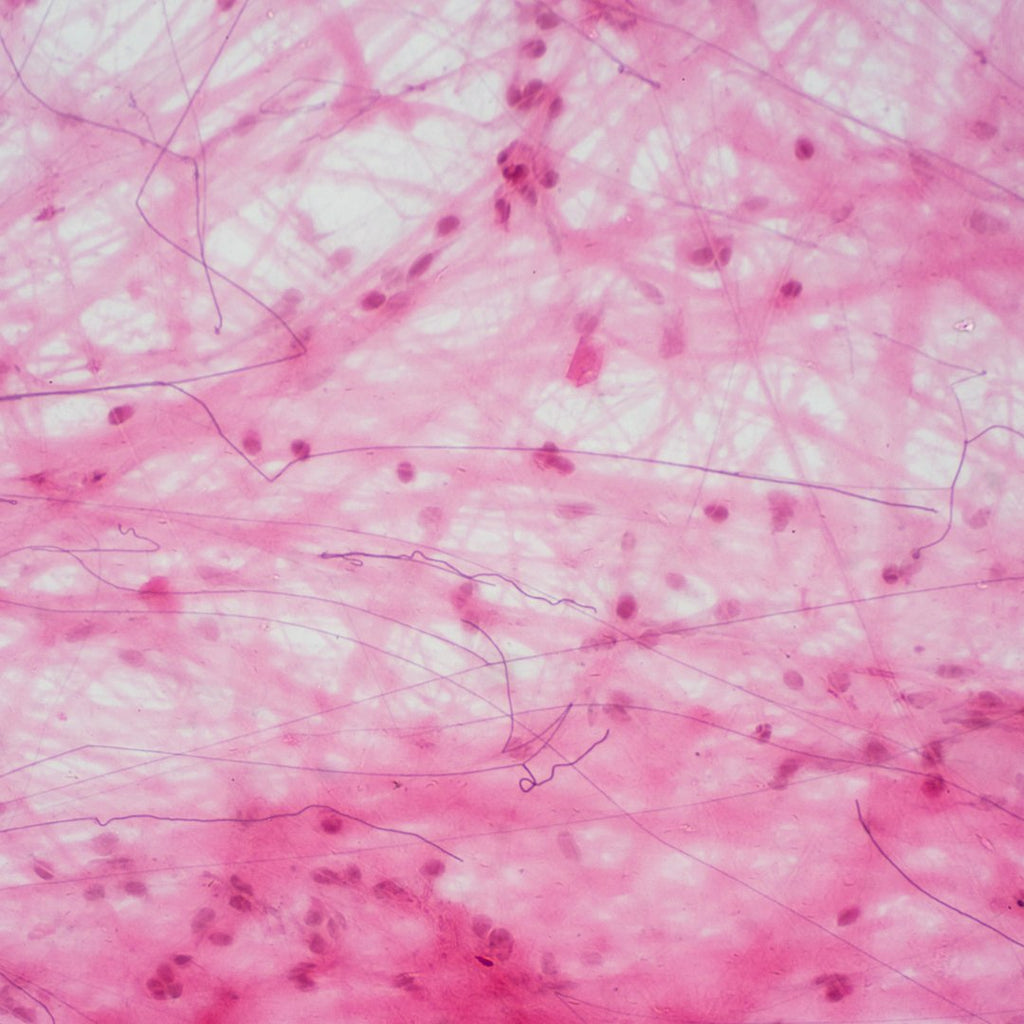with targeted nutrient interventions
Fibromyalgia syndrome (FMS) is a condition characterised by chronic widespread pain often accompanied by several non-specific symptoms including fatigue, sleep disturbances, cognitive dysfunction and depressive disorders. This complex disorder carries a genetic predisposition and is associated with abnormalities in pain mediators, such as substance P, and neurotransmitters, such as serotonin. Furthermore, there appears to be a correlation between oxidative stress and fibromyalgia, as well as dysregulation of the hypothalamic pituitary adrenal (HPA) axis, both of which can trigger or exacerbate existing inflammation. As a result of these multiple dysregulations, those suffering with FMS are constantly battling and processing a complex interaction of chemicals, hormones and proteins which, alone and in combination, give rise to a multitude of symptoms. The most common symptoms experienced on a daily basis include extreme pain in the muscles, tendons and ligaments, poor circulation, numbness in the extremities, poor concentration, memory and even depression. [1,2] Unsurprisingly, there are no specific biomarkers to diagnose fibromyalgia; however, while the management of FMS is understandably challenging, there are several nutritional approaches that may be of benefit.
Neurotransmitters, cytokines and substance P
High levels of substances that increase pain, including substance P and glutamate, have been found in the cerebrospinal fluid (CSF) of FMS patients. In addition, noradrenaline and serotonin (which are involved in the central inhibition of pain) are decreased, which may also explain why FMS patients have a higher risk for the development of depression and anxiety disorders. [3] Patients with FMS have also been shown to have an increased expression of N-methyl-d-aspartate (NMDA) receptors in their skin. [4] Sensory information, particularly relating to pain, is transmitted via the activation of the NMDA receptor (i.e. by glutamate); high numbers of overly active NMDA pain receptors helps to explain why FMS sufferers are hypersensitive to pain. As a number of NMDA agonists are present in foods (such as soya sauce and artificial sweeteners), it is extremely important that FMS patients avoid any food sources of NMDA agonists. Encouragingly, a 4-week exclusion of monosodium glutamate (MSG), aspartame and other excitotoxins showed a 30% improvement in FMS symptoms in 84% of those who completed the diet. [5]
Elevated levels of substance P (common to FMS) induces the release of pro-inflammatory cytokines IL‐8 (promotes sympathetic pain expression) and IL‐6, known to induce hyperalgesia, fatigue and depression. In addition, pro-inflammatory cytokines can act to steal tryptophan away from serotonin and melatonin pathways (via up-regulation of the enzymes IDO and TDO), increasing the activity of the NMDA agonist quinolinic acid, and further antagonising stimulation of NMDA pathways, which subsequently exacerbates mood and sleep issues. It has been observed that a number of cytokines may in fact play a direct role in FMS symptoms. [6] Magnetic resonance imaging (MRI) scans of the brains of FMS patients have shown significant shrinkage in the hippocampus; this is considered to be due to an imbalance between glutamate and gamma-aminobutyric acid (GABA) neurotransmission, together with dysregulation of glucocorticoids as a result of exposure to prolonged or traumatic stress. The shrinkage in hippocampal volume is directly linked to memory and cognitive issues experienced by FMS patients. [7]
Oxidative stress and fatigue
Increased levels of inflammatory cytokines can deplete levels of the key detoxification enzyme glutathione. The subsequent increase in oxidative stress can activate transcription factors, such as NF-κB, leading to further cytokine production. This increase in cytokine production further increases oxidative stress which in turn affects mitochondrial functioning and disrupts the production of ATP. This ATP deficit, together with inflammation and high oxidative stress, is believed to be responsible for the hallmark symptoms of ME/CFS/FMS, including post-exertion malaise. [8,9] The correlation between oxidative stress and FMS suggests that antioxidant requirements may be higher in sufferers, and while dietary manipulation can increase levels, supplementation might be more effective in achieving the levels needed to support its management.
Antioxidants that can be of benefit to FMS include:
- Polyphenols & flavonoids such as curcumin & EGCG (found in green tea) and anthocyanins (found predominantly in teas, honey, wine, fruit, vegetables, nuts, olive oil & cocoa) up-regulate glutathione-related enzymes including glutathione reductase (GR) and glutathione S-transferase (GST)
- Cruciferous vegetables such as broccoli, kale and cabbage contain antioxidants that increase the production of detoxifying enzymes in the body
- Sulphur-rich foods such as onions and garlic, cauliflower, eggs, Brussels sprouts & broccoli
- Cysteine-rich foods such as soya beans, egg white, oats & tofu, provide the body with the nutrients that make up glutathione (L-cysteine + L-glutamic acid +glycine)
Digestive health and gut bacteria
Gut issues such as IBS are common in FMS and can affect as many as 70% of cases. In addition, hypochlorhydria (the absence or low production of stomach acid) is present in as many as half of all FMS patients. [10] Interestingly, an abnormal lactulose breath test as an indication of small intestinal bacterial overgrowth (SIBO) is more common in fibromyalgia than IBS. [11] SIBO is often associated with an increased intestinal permeability and this, combined with hypochlorhydria, can exacerbate gut inflammation, leading to compromised enterocyte function, low digestive enzyme production and, because the luminal content is able to interact with immune cells, will fuel systemic inflammation. Thus nutritional support aimed at optimising gut health should be a priority.
Nutrients known to support gut heath, mucus production, support tight junctions and secretory immunoglobulin type A (SIgA) levels include:
- L-glutamine – fuels gut cells and boosts immunity
- Coconut oil/MCTs –antibacterial/antifungal
- Bone broth / gelatine / collagen
- Vitamins D3 and A – increase SigA
- Aloe vera/liquorice/quercetin
- Digestive enzymes
- Apple cider vinegar / betaine HCl supplements/high dose ascorbic acid – increase natural stomach acid
- N-acetyl glucosamine – anti-inflammatory, helps protect the lining of the stomach and intestines
- FMS may present with protein malabsorption issues
- FMS patients appear to have low BCAA (leucine, isoleucine, and valine)
Diet and lifestyle
The diet recommended to those with fibromyalgia should consist of simple, healthy and unadulterated foods, with ‘junk’ foods and foods that are processed and highly refined being completely eliminated, as they are commonly linked to the triggering of symptoms. It is also important to eat small portions at regular intervals to ensure that the body’s nutritional requirements are continuously met, without overstressing digestive capacity at any point. Choosing organic fruit and vegetable produce, where possible, will also help to ensure that contaminants such as pesticides, herbicides and fertilisers are avoided, as these can contribute to chemical sensitivity, over-stress detoxification pathways and lead to exacerbation of pain. Organic produce is also much higher in vitamins and minerals, lower in omega-6, higher in omega-3 and, importantly, is free of the steroids and hormones associated with intense farming methods; all these improvements further support healthy biochemistry, reduce inflammation and support the body’s natural ability to heal.
As well as eating well at regular intervals, patients should try to avoid/minimise stress and aim for 7-8 hours of good quality, restorative sleep as further, important aids in managing symptoms.
Targeted nutrient interventions
Research shows that a number of nutrients, when given as dietary supplements, may aid in the improvements of clinical manifestations of FMS. These include:
VESIsorb Ubiquinol
CoQ10, as ubiquinol, plays a vital role in both ATP production and as a free radical scavenger. In a 2013 study, ubiquinol supplementation (100 mg/day for 12 weeks) not only resulted in an increase in coenzyme Q10 levels but also improved chronic fatigue scores as measured by the Chalder Fatigue Scale. [13] Use of ubiquinol supplements may be a useful intervention for FMS, especially given that meta-analysis of CoQ10 supplementation studies also support its use to improve the process of inflammatory state by lowering proinflammatory cytokines. [14,15]
Super B-Complex
Longvida Curcumin
Pharmepa RESTORE & COMPLETE
Summary
FMS is clearly a highly complex syndrome in which the interaction of chemicals, hormones and proteins, both alone and in combination, give rise to a multitude of symptoms. Pain is the predominant, but not exclusive, symptom and can be triggered by a number of factors including nutrient deficiencies, high oxidative stress and unresolved inflammation, all of which are targets for nutritional support. Accumulating evidence supports the role of dietary changes in combination with targeted nutrient interventions, for successful improvement of symptom severity.
References
- Arranz LI, Canela MA, Rafecas M. Fibromyalgiaand nutrition, what do we know? Rheumatol Int. 2010 Sep;30(11):1417-27. Review.
- Rossi A, Di Lollo AC, Guzzo MP, Giacomelli C, Atzeni F, Bazzichi L, Di Franco M. Fibromyalgiaand nutrition: what news? Clin Exp Rheumatol. 2015 Jan-Feb;33(1 Suppl 88):S117-25.
- Littlejohn G. Neurogenic neuroinflammation in fibromyalgia and complex regional pain syndrome. Nat Rev Rheumatol. 2015 Nov;11(11):639-48
- Kim SH, Jang TJ, Moon IS. Increased expression of N-methyl-D-aspartate receptor subunit 2D in the skin of patients with fibromyalgia. Rheumatol. 2006 Apr;33(4):785-8.
- Holton K.F., Taren D.L., Thomson C.A., Bennett R.M., Jones K.D. The effect of dietary glutamate on fibromyalgia and irritable bowel symptoms. Clin. Exp. Rheumatol. 2012;30:10
- Generaal, E. et al. Basal inflammation and innate immune response in chronic multisite musculoskeletal pain. Pain 155, 1605–1612 (2014).
- McCrae CS, O’Shea AM, Boissoneault J, Vatthauer KE, Robinson ME, Staud R, Perlstein WM, Craggs JG. Fibromyalgia patients have reduced hippocampal volume compared with healthy controls. J Pain Res. 2015 Jan 30;8:47-52.
- Morris G, Berk M, Walder K, Maes M. Central pathways causing fatigue in neuro-inflammatory and autoimmune illnesses. BMC Med. 2015 Feb 6;13:28.
- Morris G, Maes M. A neuro-immune model of Myalgic Encephalomyelitis/Chronic fatigue syndrome. Metab Brain Dis. 2013 Dec;28(4):523-40.
- Chang L. The association of functional gastrointestinal disorders and fibromyalgia. Eur J Surg Suppl. 1998;(583):32-6. Review.
- Pimentel M, Wallace D, Hallegua D, Chow E, Kong Y, Park S, Lin HC A link between irritable bowel syndrome and fibromyalgia may be related to findings on lactulose breath testing. Ann Rheum Dis. 2004 Apr;63(4):450-2.
- Volta U. Gluten-free diet in the management of patients with irritable bowel syndrome, fibromyalgiaand lymphocytic enteritis. Arthritis Res Ther. 2014 Dec 23;16(6):505. doi: 10.1186/s13075-014-0505-1.
- Miyamae T, Seki M, Naga T, Uchino S, Asazuma H, Yoshida T, Iizuka Y, Kikuchi M, Imagawa T, Natsumeda Y, Yokota S, Yamamoto Y. Increased oxidative stress and coenzyme Q10 deficiency in juvenile fibromyalgia: amelioration of hypercholesterolemia and fatigue by ubiquinol-10 supplementation. Redox Rep. 2013;18(1):12-9
- Fan L, Feng Y, Chen GC, Qin LQ, Fu CL, Chen LH Effects of coenzyme Q10 supplementation on inflammatory markers: A systematic review and meta-analysis of randomized controlled trials. Pharmacol Res. 2017 May;119:128-136.
- Zhai J, Bo Y, Lu Y, Liu C, Zhang L. Effects of Coenzyme Q10 on Markers of Inflammation: A Systematic Review and Meta-Analysis. PLoS One. 2017 Jan 26;12(1):e0170172
- Regland B, Andersson M, Abrahamsson L, Bagby J, Dyrehag LE, Gottfries CG. Increased concentrations of homocysteine in the cerebrospinal fluid in patients with fibromyalgia and chronic fatigue syndrome. Scand J Rheumatol. 1997;26(4):301-7.
- DiSilvestro RA, Joseph E, Zhao S, Bomser J. Diverse effects of a low dose supplement of lipidated curcumin in healthy middle aged people. Nutr J. 2012 Sep 26;11:79.
- Conklin SM,Gianaros PJ, Brown SM, Yao JK, Hariri AR, Manuck SB, Muldoon MF. (2007) Long-chain omega-3 fatty acid intake is associated positively with corticolimbic gray matter volume in healthy adults. Neurosci Lett.421: 209-12.
- Puri BK, Bydder GM, Manku MS, Clarke A, Waldman AD, Beckmann CF. (2008) Reduction in cerebral atrophy associated with ethyl-eicosapentaenoic acid treatment in patients with Huntington’s disease. J Int Med Res. 36: 896-905.
- Ko GD, Nowacki NB, Arseneau L, Eitel M, Hum A (2010) Omega-3 fatty acids for neuropathic pain: case series. Clin J Pain. 26: 168-72.






